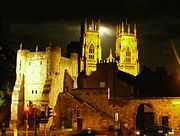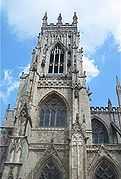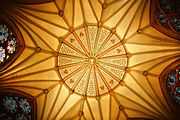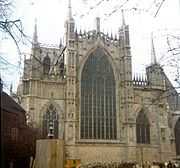York Minster
| York Minster | |
|---|---|
| Cathedral and Metropolitical Church of St Peter | |
 Transept and crossing tower of York Minster from the south east | |
 York Minster | |
| 53°57′43″N 1°4′55″W / 53.96194°N 1.08194°WCoordinates: 53°57′43″N 1°4′55″W / 53.96194°N 1.08194°W | |
| Location | York, North Yorkshire |
| Country | England |
| Denomination | Church of England |
| Previous denomination | Roman Catholic |
| Tradition | Anglo-Catholic |
| Website | www.yorkminster.org |
| Architecture | |
| Previous cathedrals | at least 3 |
| Style | Early English, Perpendicular |
| Specifications | |
| Length | 173 yards (158 m)[citation needed] |
| Choir height | 102 feet (31 m)[citation needed] |
| Number of towers | 3 |
| Tower height |
Central Tower: 200 feet (61 m)[citation needed] Western Towers: 174 feet (53 m)[citation needed] |
| Administration | |
| Diocese | York (since 314) |
| Province | York |
| Clergy | |
| Bishop(s) | John Sentamu |
| Dean | Vivienne Faull |
| Precentor | Peter Moger |
| Canon Chancellor | Vacant |
| Canon(s) | Canon Pastor (Vacant) |
| Archdeacon | Suzanne Sheriff, Temporary Archdeacon of York |
| Laity | |
| Director of music | Robert Sharpe |
| Business manager | Richard Shephard (Director of development and Chamberlain) |
York Minster is a cathedral in York, England, and is one of the largest of its kind in Northern Europe. The minster is the seat of the Archbishop of York, the second-highest office of the Church of England, and is the cathedral for the Diocese of York. It is run by a dean and chapter, under the Dean of York. The formal title of York Minster is "The Cathedral and Metropolitical Church of St Peter in York".[1] The title "minster" is attributed to churches established in the Anglo-Saxon period as missionary teaching churches, and serves now as an honorific title.[1] Services in the minster are sometimes regarded as on the High Church or Anglo-Catholic end of the Anglican continuum.[2]
The minster has a very wide Decorated Gothic nave and chapter house, a Perpendicular Gothic Quire and east end and Early English north and south transepts. The nave contains the West Window, constructed in 1338, and over the Lady Chapel in the east end is the Great East Window, (finished in 1408), the largest expanse of medieval stained glass in the world. In the north transept is the Five Sisters Window, each lancet being over 52 feet (16 m) high.[citation needed] The south transept contains a famous rose window, while the West Window contains a famous heart-shaped design, colloquially known as 'The Heart of Yorkshire'.
History
York has had a verifiable Christian presence from the 4th century. However there is circumstantial evidence pointing to much earlier Christian involvement. According to Bede missionaries were sent from Rome by Eleutherius at the request of the chieftain Lucius of Britain in AD 180 to settle controverted points of differences as to Eastern and Western ceremonials which were disturbing the church. Tradition speaks of 28 British bishops, one for each of the greater British cities, over whom presided the Archbishops of London, York and Caerleon-on-Usk.
The first recorded church on the site was a wooden structure built hurriedly in 627 to provide a place to baptise Edwin, King of Northumbria. Moves toward a more substantial building began in the 630s. A stone structure was completed in 637 by Oswald and was dedicated to Saint Peter. The church soon fell into disrepair and was dilapidated by 670 when Saint Wilfrid ascended to the see of York. He repaired and renewed the structure. The attached school and library were established and by the 8th century were some of the most substantial in Northern Europe.[citation needed][3]
In 741 the church was destroyed in a fire. It was rebuilt as a more impressive structure containing thirty altars. The church and the entire area then passed through the hands of numerous invaders, and its history is obscure until the 10th century. There was a series of Benedictine archbishops, including Saint Oswald, Wulfstan and Ealdred, who travelled to Westminster to crown William in 1066. Ealdred died in 1069 and was buried in the church.[4]
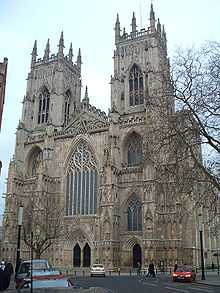
The church was damaged in 1069 during William the Conqueror's harrying of the North, but the first Norman archbishop, Thomas of Bayeux, arriving in 1070, organised repairs. The Danes destroyed the church in 1075, but it was again rebuilt from 1080. Built in the Norman style, it was 111 m (364.173 ft) long and rendered in white and red lines. The new structure was damaged by fire in 1137 but was soon repaired. The choir and crypt were remodelled in 1154, and a new chapel was built, all in the Norman style.
The Gothic style in cathedrals had arrived in the mid 12th century. Walter de Gray was made archbishop in 1215 and ordered the construction of a Gothic structure to compare to Canterbury; building began in 1220. The north and south transepts were the first new structures; completed in the 1250s, both were built in the Early English Gothic style but had markedly different wall elevations. A substantial central tower was also completed, with a wooden spire. Building continued into the 15th century.
The Chapter House was begun in the 1260s and was completed before 1296. The wide nave was constructed from the 1280s on the Norman foundations. The outer roof was completed in the 1330s, but the vaulting was not finished until 1360. Construction then moved on to the eastern arm and chapels, with the last Norman structure, the choir, being demolished in the 1390s. Work here finished around 1405. In 1407 the central tower collapsed; the piers were then reinforced, and a new tower was built from 1420. The western towers were added between 1433 and 1472. The cathedral was declared complete and consecrated in 1472.[5]

The English Reformation led to the looting of much of the cathedral's treasures and the loss of much of the church lands. Under Elizabeth I there was a concerted effort to remove all traces of Roman Catholicism from the cathedral; there was much destruction of tombs, windows and altars. In the English Civil War the city was besieged and fell to the forces of Cromwell in 1644, but Thomas Fairfax prevented any further damage to the cathedral.
Following the easing of religious tensions there was some work to restore the cathedral. From 1730 to 1736 the whole floor of the minster was relaid in patterned marble and from 1802 there was a major restoration. However, on 2 February 1829, an arson attack by a non-conformist, Jonathan Martin,[6] inflicted heavy damage on the east arm. An accidental fire in 1840 left the nave, south west tower and south aisle roofless and blackened shells. The cathedral slumped deeply into debt and in the 1850s services were suspended. From 1858 Augustus Duncome worked successfully to revive the cathedral.
During the 20th century there was more concerted preservation work, especially following a 1967 survey that revealed the building, in particular the central tower, was close to collapse. £2,000,000 was raised and spent by 1972 to reinforce and strengthen the building foundations and roof. During the excavations that were carried out, remains of the north corner of the Roman Principia (headquarters of the Roman fort, Eboracum) were found under the south transept. This area, as well as remains of the Norman cathedral, re-opened to the public in spring 2013 as part of the new exhibition exploring the history of the building of York Minster.[7]
On 9 July 1984, a fire believed to have been caused by a lightning strike[8] destroyed the roof in the south transept, and around £2.5 million was spent on repairs. Restoration work was completed in 1988, and included new roof bosses to designs which had won a competition organised by BBC Television's Blue Peter programme. In 2007 renovation began on the east front, including the Great East Window, at an estimated cost of £23 million.[9][10]
In 2000, the Dean and Chapter allowed the famous York Mystery Plays to be performed for the first time inside the Minster, directed by Greg Doran.[11] Here is a link to a page of photographs about that production, held at the National Centre for Early Music. http://www.yorkmysteryplays.org/default.asp?idno=204
Architecture of the present building

York Minster is the second largest Gothic cathedral of Northern Europe and clearly charts the development of English Gothic architecture from Early English through to the Perpendicular Period. The present building was begun in about 1230 and completed in 1472. It has a cruciform plan with an octagonal chapter house attached to the north transept, a central tower and two towers at the west front. The stone used for the building is magnesian limestone, a creamy-white coloured rock that was quarried in nearby Tadcaster. The Minster is 173 yards (158 m) long[citation needed] and each of its three towers are 200 feet (61 m) high.[citation needed] The choir has an interior height of 102 feet (31 m).[citation needed]
The north and south transepts were the first parts of the new church to be built. They have simple lancet windows, the most famous being the Five Sisters in the north transept. These are five lancets, each 52 feet (16 m) high[citation needed] and glazed with grey (grisaille) glass, rather than narrative scenes or symbolic motifs that are usually seen in medieval stained glass windows. In the south transept is a famous rose window whose glass dates from about 1500 and commemorates the union of the royal houses of York and Lancaster. The roofs of the transepts are of wood, that of the south transept was burnt in the fire of 1984 and was replaced in the restoration work which was completed in 1988. New designs were used for the bosses, five of which were designed by winners of a competition organised by the BBC's Blue Peter television programme.

Work began on the chapter house and its vestibule that links it to the north transept after the transepts were completed. The style of the chapter house is of the early Decorated Period where geometric patterns were used in the tracery of the windows, which were wider than those of early styles. However, the work was completed before the appearance of the ogee curve, an S-shaped double curve which was extensively used at the end of this period. The windows cover almost all of the upper wall space, filling the chapter house with light. The chapter house is octagonal, as is the case in many cathedrals, but is notable in that it has no central column supporting the roof. The wooden roof, which was of an innovative design, is light enough to be able to be supported by the buttressed walls. The chapter house has many sculptured heads above the canopies, representing some of the finest Gothic sculpture in the country. There are human heads, no two alike, and some pulling faces; angels; animals and grotesques. Unique to the transepts and chapter house is the use of Purbeck marble to adorn the piers, adding to the richness of decoration.

The nave was built between 1291 and c. 1350 and is also in the decorated Gothic style. It is the widest Gothic nave in England and has a wooden roof (painted so as to appear like stone) and the aisles have vaulted stone roofs. At its west end is the Great West Window, known as the 'Heart of Yorkshire' which features flowing tracery of the later decorated gothic period.
The east end of the Minster was built between 1361 and 1405 in the Perpendicular Gothic style. Despite the change in style, noticeable in details such as the tracery and capitals, the eastern arm preserves the pattern of the nave. The east end contains a four bay choir; a second set of transepts, projecting only above half-height; and the Lady Chapel. The transepts are in line with the high altar and serve to throw light onto it. Behind the high altar is the Great East Window, the largest expanse of medieval stained glass in the world, which is currently undergoing a massive conservation project, due to be completed in 2015–16. Below the Great East Window currently sits the Orb, a stainless steel dome which opened at the end of October 2012, containing five of the conserved panels from the window, one of which is changed each month. The Orb enables visitors to see the work of renowned medieval artist, John Thornton, up close, revealing the remarkable detail in each panel.
The sparsely decorated Central Tower was built between 1407 and 1472 and is also in the Perpendicular style. Below this, separating the choir from the crossing and nave is the striking 15th century choir screen. It contains sculptures of the kings of England from William the Conqueror to Henry VI with stone and gilded canopies set against a red background. Above the screen is the organ, which dates from 1832. The West Towers, in contrast with the Central Tower, are heavily decorated and are topped with battlements and eight pinnacles each, again in the Perpendicular style.
Stained glass

York as a whole, and particularly the minster, have a long tradition of creating beautiful stained glass. Some of the stained glass in York Minster dates back to the 12th century. The Minster's records show that much of the glass (white or coloured) came from Germany.[12] Upon arrival at York, it was intricately painted, fired, then glazed together with lead strips into the windows. The 76-foot (23 m)[citation needed] tall Great East Window, created by John Thornton in the early 15th century, is the largest expanse of medieval stained glass in the world. Other windows in the minster include an ornate rose window and the 50-foot (15 m)[citation needed] tall Five Sisters window. Because of the extended time periods during which the glass was installed, different types of glazing and painting techniques which evolved over hundreds of years are visible in the different windows. Approximately two million individual pieces of glass make up the cathedral's 128 stained glass windows. Much of the glass was removed before and pieced back together after the First and Second World Wars, and the windows are constantly being cleaned and conserved to keep their beauty intact.
In 2008 a major conservation project of the Great East Window commenced, involving the removal, repainting and re-leading of each individual panel.[13] While the window was in storage in the minster's stonemasons' yard, a fire broke out in some adjoining offices, due to an electrical fault, on 30 December 2009.[14] The window's 311 panes, stored in a neighbouring room, were undamaged and were successfully moved to safety.[15][16]
Towers and bells
The two west towers of the minster hold bells, clock chimes and a concert carillon. The north-west tower contains Great Peter (216 cwt or 10.8 tons) and the six clock bells (the largest weighing just over 60 cwt or 3 tons). The south-west tower holds 14 bells (tenor 59 cwt or 3 tons) hung and rung for change ringing and 22 carillon bells (tenor 23 cwt or 1.2 tons) which are played from a baton keyboard in the ringing chamber (all together 35 bells.)
The clock bells ring every quarter of an hour during the daytime and Great Peter strikes the hour. The change ringing bells are rung regularly on Sundays before church services and at other occasions, the ringers practise on Tuesday evenings. York Minster became the first cathedral in England to have a carillon of bells with the arrival of a further twenty-four small bells on 4 April 2008. These are added to the existing "Nelson Chime" which is chimed to announce Evensong around 5.00 pm each day, giving a carillon of 35 bells in total (three chromatic octaves). The new bells were cast at the Loughborough Bell Foundry of Taylors, Eayre & Smith, where all of the existing minster bells were cast. The new carillon is a gift to the minster. It will be the first new carillon in the British Isles for 40 years and first hand played carillon in an English cathedral. Before Evensong each evening, hymn tunes are played on a baton keyboard connected with the bells, but occasionally anything from Beethoven to the Beatles may be heard.[17]
Shrines
When Thomas Becket was murdered and subsequently enshrined at Canterbury, York found itself without a rival major draw for pilgrims. More specifically, pilgrims spent money and would leave gifts for the support of the cathedral. Hence Walter de Gray, supported by the King, petitioned the Pope. On 18 March 1226, Pope Honorius issued a letter to the effect that the name of William (Fitzherbert), formerly Archbishop of York. was "inscribed in the catalogue of the Saints of the Church Militant." Thus there was now St William of York (whose name is perhaps more often associated with the adjacent St William's College). York had its saint but it took until 1279, when William de Wickwane (William de Wykewayne) was elected archbishop, for the remains of the canonised William to be transferred to a shrine prepared for them behind the high altar.[18] This was placed on a platform raised upon the arches of the crypt removed to this position for that purpose. On 29 December King Edward I himself, together with the bishops who were present, carried on their shoulder the chest or feretory containing the relics to their new resting-place and Anthony Beck, consecrated the same day as Bishop of Durham, paid all the expenses.
The tomb of Walter de Gray was erected in the south transept. His remains were interred on "the vigil of Pentecost, 1255"[18] under his effigy "in full canonicals" carved in Purbeck marble under a canopy resting on ten light pillars. It was subsequently somewhat hidden behind a screen of ironwork erected by Archbishop William Markham in the early 19th century.
Organ

The fire of 1829 destroyed the organ and the basis of the present organ dates from 1832, when Elliot and Hill constructed a new instrument. This organ was reconstructed in 1859 by William Hill and Sons. The case remained intact, but the organ was mechanically new, retaining the largest pipes of the former instrument.
In 1903, J.W. Walker and Sons built a new instrument in the same case. They retained several registers from the previous instrument.
Some work was undertaken in 1918 by Harrison & Harrison when the famous Tuba Mirabilis was added and the Great chorus revised. The same firm rebuilt this Walker-Harrison instrument in 1931 when a new console and electro-pneumatic action were added together with four new stops. The smaller solo tubas were enclosed in the solo box. In 1960, J.W. Walker & Sons restored the actions, lowered wind pressures and introduced mutations and higher chorus work in the spirit of the neo-classical movement. They cleaned the organ in 1982.
The fire of 1984 affected the organ but not irreparably; the damage hastened the time for a major restoration, which was begun in 1991 and finished two years later by Principal Pipe Organs of York, under the direction of their founder, Geoffrey Coffin, who had at one time been assistant organist at the Minster.[19]
Organists
The organists of York Minster have had several official titles, the job description roughly equates to that of Organist and Master of the Choristers. The current Organist and Director of Music of the minster is Robert Sharpe. There is also an assistant director of music, David Pipe, and an organ scholar.
Among the notable organists of York Minster are four members of the Camidge family, who served as the cathedral's organists for over 100 years, and a number of composers including John Naylor, T. Tertius Noble and Francis Jackson.
Dean and chapter
- Dean: The Very Revd Vivienne Faull (since 1 December 2012 installation[20])
- Precentor: The Revd Canon Peter Moger (since 12 September 2010 installation[21])
- Pastor: The Reverend Michael Smith
- Chancellor: The Reverend Canon Christopher Collingwood
- Acting Archdeacon of York: The Revd Suzanne Sheriff (since December 2012)
Burials
|
|
- This list is incomplete; you can help by expanding it.
Astronomical clock
The astronomical clock was installed in the North Transept of York Minster in 1955. The clock is a memorial to the airmen operating from bases in Yorkshire, County Durham and Northumberland who were killed in action during the Second World War.[22]
Illuminations

In November 2002, York Minster was illuminated in colour, devised by York-born Mark Brayshaw, for the first time in its history. The occasion was televised live on the BBC1 Look North programme. Similar illuminations have been projected over the Christmas period in subsequent years.
York Minster was also artistically illuminated on 5 November 2005, celebrating the 400th anniversary of the foiling of York-born Guy Fawkes' gunpowder plot. This was done by Patrice Warrener using his unique "chromolithe" technique with which he 'paints' with light, picking out sculpted architectural details.
In October 2010, York Minster's South transept was selected for 'Rose' a son et lumiere, created by international artists Ross Ashton and Karen Monid, which lit up the entire exterior of the South transept of the Minster and illuminated the Rose Window. There were also satellite illuminate events in Dean's Park.
Photo gallery
|
See also
- The Minster School, York
- Archbishop's Palace, Bishopthorpe
- Architecture of the medieval cathedrals of England
- York Minster Police
- Cathedral diagram
References
- ↑ 1.0 1.1 York Minster FAQs, www.yorkminster.org. Retrieved on 1 January 2010.
- ↑ "York Minster Cathedral". DooYoo.co.uk. 28 March 2008.
- ↑ The most renowned product of the school was Alcuin.
- ↑ "Britannia Biographies: Ealdred, Archbishop of York". notesfromtheroad.net. Retrieved 2 June 2009.
- ↑ "The Medieval Minster: History of York". www.historyofyork.org.uk. Retrieved 2 June 2009.
- ↑ "Jonathan Martin: The Man Who Burned York Minster". www.bbc.co.uk. Retrieved 16 March 2009.
- ↑ http://www.yorkminster.org/about-us/york-minster-revealed-ymr.html
- ↑ "1984: York Minster ablaze". BBC News. 9 July 1984. Retrieved 24 June 2010.
- ↑ "York Minster: a very brief history". www.yorkminster.org. Retrieved 5 October 2008.
- ↑ "York Minster Press Pack" (PDF). Retrieved 5 October 2008.
- ↑ Archive of Mystery Plays at National Centre for Early Music.
- ↑ Gibson, Peter (1979). The Stained and Painted Glass of York Minster. Norwich: Jarrold Publishing. pp. 5–6. ISBN 085306833X.
- ↑ "The ONE Show". 29 January 2008. BBC 1.
- ↑ "York Minster Stoneyard blaze caused by electrical fault", York Press. Retrieved on 1 January 2010.
- ↑ York Minster fire: medieval stained glass window saved Daily Telegraph, 31 December 2009
- ↑ "Fire crews rescue medieval York Minster window". BBC News Online (BBC). 31 December 2009. Retrieved 6 January 2010.
- ↑ Peacock, Alix (4 April 2008). "New Bells for York Minster". Minster News. York Minster. Retrieved 10 August 2009.
- ↑ 18.0 18.1 Purey-Cust, A. P. The Very Reverend Dean York Minster (1897) Isbister & Co
- ↑ National Pipe Organ Register- York Minster
- ↑ Diocese of Leicester – Installation of Faull as Dean of York
- ↑ York Press – Moger to take charge of Minster services
- ↑ "50th Anniversary of the Astronomical Clock" (PDF). York Minster News. York Minster. December 2005. Retrieved 27 July 2008.
- Brown, Sarah (1999). Stained Glass at York Minster. London: Scala in association with the Dean and Chapter of York. ISBN 1-85759-219-0.
- Pevsner, Nikolaus; Neave, David (1995) [1972]. Yorkshire: York and the East Riding (2nd ed.). London: Penguin Books. ISBN 0-14-071061-2.
- Willey, Ann (1998). York Minster. London: Scala. ISBN 1-85759-188-7.
External links
| Wikimedia Commons has media related to York Minster. |
- Independent travel guide to York Minster with pictures
- York Minster information and pictures
- York Minster Information and Images www.theminsteryork.co.uk
- York Minster
- History of York – the Minster theme on the city's history website
- Photo essay on interior of York Minster
- VR York Tour Virtual Tour of York Minster – view the interior and exterior of the Minster in York
- York Minster, QuickTime image
- Photos
- A history of the choristers of York Minster
- The Guardian Christmas illuminations
- The Cathedral Church of York, 1899, by A. Clutton-Brock, from Project Gutenberg
- Photos and plans
- Sound of the chime and photography of York Minster
- – "Rose" by Ross Ashton & Karen Monid – "son et lumiere" images.
| ||||||||||||||
